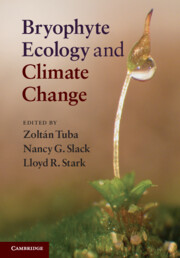Book contents
- Frontmatter
- Contents
- List of contributors
- Preface
- I Introductory Chapters
- II Ecophysiology
- III Aquatic Bryophytes
- IV Desert and Tropical Ecosystems
- V Alpine, Arctic, and Antarctic Ecosystems
- VI Sphagnum and Peatlands
- VII Changes in Bryophyte Distribution with Climate Change: Data and Models
- VIII Conclusions
- 23 Bryophytes as Predictors of Climate Change
- 24 Conclusions and Future Research
- Index
- References
23 - Bryophytes as Predictors of Climate Change
Published online by Cambridge University Press: 05 October 2012
- Frontmatter
- Contents
- List of contributors
- Preface
- I Introductory Chapters
- II Ecophysiology
- III Aquatic Bryophytes
- IV Desert and Tropical Ecosystems
- V Alpine, Arctic, and Antarctic Ecosystems
- VI Sphagnum and Peatlands
- VII Changes in Bryophyte Distribution with Climate Change: Data and Models
- VIII Conclusions
- 23 Bryophytes as Predictors of Climate Change
- 24 Conclusions and Future Research
- Index
- References
Summary
Introduction
Increases in atmospheric greenhouse gases that produce positive radiative forcings are having large-scale impacts on the global climate system, such as increases in temperatures, changes in precipitation patterns, and changes in the frequency of severe weather events. The greatest impact is occurring at high latitudes in the northern hemisphere, at high altitudes throughout the world, and in Antarctica and the sub-Antarctic Islands. Because of their efficient long-distance dispersal mechanisms and their high fidelity to climatically sensitive habitats, bryophytes should react quickly to changes to their environment and thus have the potential of being effective predictors of current climate change.
Since the beginning of the industrial era approximately 200 years ago, carbon dioxide (CO2), methane (CH4), and nitrous oxide (N2O) concentrations have been increasing exponentially in the atmosphere (IPCC 2001). Concentrations of other greenhouse gases such as halocarbons and perfluorocarbons that are produced by anthropogenic activities are also increasing in the atmosphere. As a result of greenhouse gas enrichment, global mean surface air temperatures have risen by about 0.3–0.6 °C since the nineteenth century and by 0.2–0.3 °C over the past 40 years (IPCC 2001). The largest temperature increases have occurred over the northern hemisphere land mass north of 40° latitude (Serreze et al. 2000), on widespread high-altitude mountains throughout the world (Böhm et al. 2001), and in the Antarctic (Nyakatya & McGeoch 2008). Temperature increases have also been observed at low latitudes, although to a lesser extent than at high latitudes (Dash et al. 2007; Malhi et al. 2008).
- Type
- Chapter
- Information
- Bryophyte Ecology and Climate Change , pp. 461 - 482Publisher: Cambridge University PressPrint publication year: 2011
References
- 6
- Cited by

